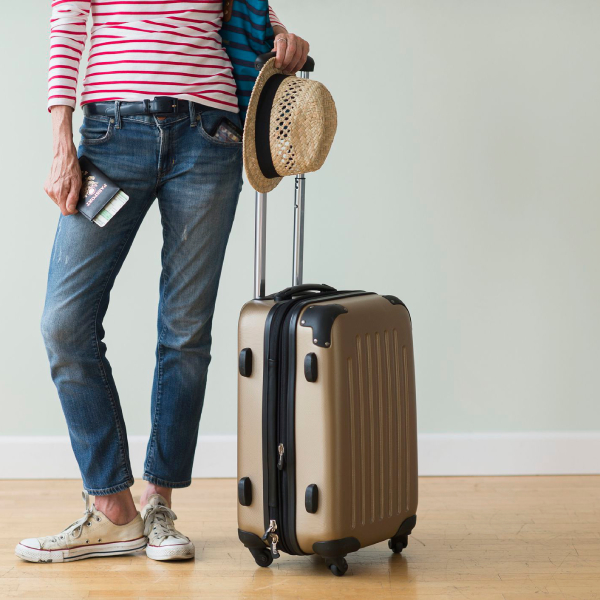The Importance of Carry-On Sizes for International Travel
Choosing the right carry-on luggage for international travel is crucial. Each airline sets its own size and weight guidelines for carry-on items. Not following these can lead to extra fees or checked bags at the gate. With the right carry-on, you avoid long waits at baggage claims. It also means you can move easily between connecting flights and different modes of transport.

Carry-on luggage international size varies, but there’s a good reason. Airlines must manage limited cabin space while ensuring passenger safety. Smaller-sized carry-on bags help to meet these needs. They fit in overhead bins or under seats with ease.
By sticking to the proper carry-on size, travelers save time and stress. They can breeze through airport security and onto their flight. Packing within the size restrictions also helps in planning. You’ll only bring what you need, making your trip more enjoyable.
While it’s tempting to pack everything, a carefully packed carry-on bag is key. It can hold all essentials and still comply with airline policies. This ensures a smoother and hassle-free transit through airports worldwide. When preparing for a carnival cruise, a well-organized carry-on is essential. It keeps your essentials handy and makes airport transitions effortless.
Lastly, knowing the right carry-on size aids in packing efficiency. It encourages travelers to prioritize and pack smart. This way, they experience less trouble during checks and more peace of mind while traveling.
Tips for Packing a Carry-On for Long Trips
Packing a carry-on for long trips requires smart planning and strategy. Here are some carry-on luggage international size-friendly tips to pack effectively:
- Choose Versatile Clothing: Select items that can be mixed and matched. This reduces the number of outfits needed.
- Wear Your Bulkier Items: To save space, wear the heavier shoes and jackets during your flights.
- Utilize Packing Cubes: These keep clothes organized and compressed, freeing up valuable space.
- Limit Toiletries: Bring travel-sized toiletries within the 100ml limit. Consider solid bars instead of liquids.
- Prioritize Essentials: Think critically about what you really need. Leave behind items that aren’t necessary.
- Roll, Don’t Fold: Rolling clothes instead of folding can save space and reduce wrinkles.
- Electronic Copies: Keep digital versions of important documents. This avoids carrying extra papers.
- Laundry Options: If possible, plan to do laundry on your trip. This allows you to pack fewer clothes.
Remember, the goal is to stay within international carry-on size restrictions. Keep it light, keep it smart, and enjoy a hassle-free journey!

Understanding International Carry-On Size Restrictions
When flying internationally, being familiar with carry-on size restrictions is essential. Each airline has its own rules, which can vary considerably. Knowing these can prevent inconvenience and extra costs. Not only do size limits differ, but some airlines are strict about enforcing them. This means double-checking your carry-on’s dimensions before heading to the airport. When considering your carry-on items, remember that a carry-on razor may be subject to specific airline regulations. Always check the rules to avoid any last-minute surprises at security.
Here are key points to consider:
- Airline Specifics: Always check the airline’s website for their size limits for carry-on luggage.
- Standard Size: A common size to aim for is 22 inches by 14 inches by 9 inches.
- International Variation: Some countries have stricter rules, with smaller size allowances.
- Flexibility: Soft-sided bags could offer more leeway with tighter restrictions.
- Measurements: Account for wheels and handles when measuring your carry-on.
- Multi-Carrier Travel: If you’re switching airlines, know each one’s limitations.
It’s not just about comfort or avoiding fees. Proper carry-on size ensures safety aboard. Overstuffed or oversized bags can cause issues in emergencies. They also take up more than their fair share of cabin space. By adhering to size restrictions, you respect fellow travelers’ space as well.
Follow the carry-on size guidelines for an easier, stress-free travel experience. This way, you’re likelier to keep your belongings with you and avoid delays or unexpected checks.
Weight Limits for Carry-On Luggage on International Flights
Before you fly, check the weight limits for carry-on luggage. Every airline has different rules. Some are strict and may weigh your bag at the gate. Others are more relaxed, allowing heavier bags on board. A heavy carry-on can cause trouble, like extra fees or gate-checking.
Here’s what to keep in mind:
- Check Airline Policies: Look up weight limits on airline websites. Not all airlines are the same.
- Expect Weigh-ins: Especially in Europe, some airlines weigh carry-on bags pre-boarding.
- Understand Limits: They often range from 15-50 pounds. Pack within these limits to avoid issues.
- Economy vs. Premium: Higher class tickets might allow more weight. See if you qualify.
- Weigh Beforehand: Use a scale at home. This can prevent surprises and repacking at the airport.
- Know the Fees: Overweight bags cost more. Find out how much so you’re not caught off guard.

By following these rules, you can avoid delays and keep travel smooth. Remember, light packing is key for hassle-free international travel. Keep your carry-on within the airline’s weight restrictions to ensure a smooth journey.
Dimensions: Finding a Carry-On that Fits Any Airline
Finding a carry-on for any airline can be tricky. To simplify this, aim for a bag that fits universal dimensions. Most airlines consider 22 inches by 14 inches by 9 inches as standard. This size should fit in the overhead compartment or under the seat in front of you. When choosing carry-on luggage, ensure it meets international size standards. A bag within 22 x 14 x 9 inches is ideal for most airlines.
Before you buy, check your most-used airlines for their size guidelines. Some airlines might allow slightly bigger or smaller carry-on bags. However, if you stick to the dimensions above, you should be safe with most carriers. Additionally, consider the following tips:
- Look for Adjustable Bags: Choose a carry-on with expandable sides or adjustable straps. This will give you flexibility within size restrictions.
- Opt for Lightweight Materials: A lighter bag means you can pack more without hitting weight limits.
- Check the Design: Ensure the carry-on has a good layout. Look for compartments that make use of space efficiently.
- Test the Handles and Wheels: Sturdy wheels and handles that retract fully can prevent size issues.
Lastly, keep in mind that while these tips can help, it’s best to check each airline’s specific carry-on luggage international size policy before flying. This ensures you won’t face any surprises at the gate and can travel with ease. Always measure your bag before a trip, including handles and wheels, to make sure it fits size regulations.
The Difference Between Carry-Ons and Personal Items on Flights
When packing for a flight, it’s essential to distinguish between carry-on luggage and personal items. Here’s how they differ and how to manage both when travelling internationally:
- Carry-On Luggage: This is the larger bag you store in the overhead bin. It has strict size and weight limits set by the airline. Ideally, it holds most items you’ll need during your trip.
- Personal Items: These are smaller bags like purses, laptop bags, or briefcases. They fit under the seat in front of you. Airlines usually allow one personal item in addition to your carry-on.
Understanding these differences is key to packing effectively. Here are strategies to ensure you meet airline regulations:
- Use Personal Items Wisely: Place crucial items in your personal item for easy access during the flight.
- Check Size Limits: Ensure both your carry-on and personal item meet the airline’s size criteria.
- Prepare for Restrictions: Some airlines allow only one piece on board. In this case, your personal item must fit within your carry-on.
- Pack Smart: Store valuables and essentials in your personal item. This way, they stay with you in case you have to gate-check your carry-on.
By recognizing the role of each type of luggage, you can pack smart and avoid surprises. Always verify your airline’s policies on carry-on luggage international size and restrictions before travel.
Packing Strategies for Complying with Stringent Airline Policies
To ensure compliance with airline carry-on policies, adopt these packing strategies:
- Start with the Right Bag: Choose a bag that fits global carry-on size standards. Look for something lightweight and robust.
- Review Airline Restrictions: Before packing, confirm the airline’s size and weight limits for carry-on luggage.
- Use Packing Aids: Packing cubes and compression bags help manage space and reduce volume.
- Maximize Personal Items: If permitted, use your personal item for extra storage. Keep necessities within reach.
- Strategic Clothing Choices: Pick clothes that are versatile. Wear the bulkier items on board to save space.
- Check Luggage Features: Bags with multiple compartments allow for better organization. Extra features can add unnecessary bulk and weight.
- Evaluate Every Item: Think carefully about each item’s necessity. Leave behind anything not essential for the trip.
- Prepare for Weigh-ins: Some airlines weigh bags. Pack a portable luggage scale to avoid surprises at the airport.
- Prioritize Digital: Opt for digital documents to save on space and weight.
Staying within carry-on luggage international size limits is crucial. Adhering to these strategies eases the stress of travel and ensures a smoother boarding process. Always verify dimensions and weight before leaving for the airport to dodge any last-minute repacking or fees. Keep it simple, organized, and within the rules for a hassle-free start to your journey.
Pre-Travel Checklist: Verifying Carry-On Size and Weight Limits
Before you travel, it’s smart to verify carry-on size and weight limits. Doing this prevents extra fees and the stress of having to check your bag last-minute. Here’s a simple pre-travel checklist to make sure your luggage is up to snuff:
- Measure Your Bag: Use a tape measure to check your carry-on’s dimensions. Include wheels and handles. Aim for 22 inches by 14 inches by 9 inches to be safe. Keep in mind, some airlines may have tighter size restrictions.
- Check Airline Policies: Visit the airline’s website to find their specific requirements. Look for the section on carry-on luggage international size and weight limits. Print out these details or save them on your phone for quick access.
- Weigh Your Luggage: Use a home luggage scale to weigh your bag. Make sure it’s within the airline’s limit, often between 15-50 pounds. Weighing ahead saves time and hassle at the airport.
- Verify Personal Item Size: If you’re bringing a personal item, check it fits the airline’s guidelines. It should slide under the seat in front of you with ease. Remember, some airlines only allow one piece of cabin baggage.
- Trim and Tweak: If your bag’s too heavy or too large, reconsider what’s packed. Swap out heavy items, or wear bulkier layers on the flight. Leave non-essentials at home to lighten the load.
- Double-Check Before Departure: Give your bag one last review before you head to the airport. This final check ensures you meet all requirements. This step is especially important if you switch airlines during your trip.
Follow this checklist and pack smart. Doing so will ensure your carry-on luggage fits international size standards. This makes your travel smoother and more enjoyable.